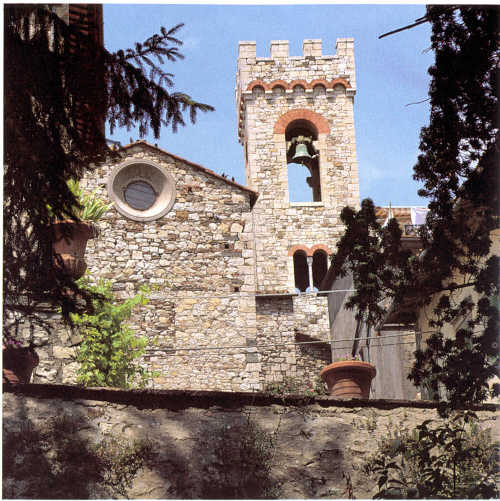
Radda in Chianti ancient village of the Legue of Chianti
The surroundings of Radda in Chianti have several interesting place to visit: an half day tour can be dovoted to visit the Castello di Monterinaldi, Castello di Volpaia, Castello d'Albola and Santa Maria Novella
Located in the heart of the Chianti hills, Radda has maintained its
charm intact from time immemorial. In the 50's its land and farmhouses were abandoned, but
with its rediscovery in the 70's the old terraced olive groves and vineyards which by this time had fallen
into disuse gave way to more intensive and extensive farming.
Consequently the resumption of activity by the numerous large and small Agricultural Aziendas of
the area, which fall within Chianti Classico boundaries along with top-quality wine and olive oil
production famous even abroad, in recent years new artisans' and small industries - particularly in the construction,
furniture, ceramic and terra cotta sectors - bave begun to make a Dame for themselves.
Further development of the Agritourism sector and an increase in accomodation facilities has
gone hand in hand with the increase in tourism.
Radda's origins go back to 2000 BC when the first human settlement was established at Poggio alla
Croce where remains of the ancient village and archeological finds bave been brought to light in
recent years. The Etruscan settlemenls which followed left only a few traces, which
are visible today as the foundations of some farmhouses and in clay pottery. In the V century AD when the Roman Empire
fell due to the invasion of the Barbarians, Chianti consisted of small villages made up of 5 to 6 houses, whose names ring true today:
Radda, Monterinaldi, Volpaia, Castelvecchi,
Albola. In IX-X AD and the beginning of the feudal area, fortification of Chianti began
under Count Guidi and the Marchesi of Toscana; Radda became populated and started to grow. In 1100 Radda (whose Dame "Ratta"
appears in an historic document of 1003) was the largest and most important in the area, also due to its
central position and the vast area it could control. From the XI century on, a sharecropping
system began to develop wherein the landowners gave small pieces of land to farmers who occupied
rural houses often grouper around a church. Thus, local Priories were formed, which assumed
considerable importance in the administration of all the smaller churches and whose duties included the care of the sick, the housing of the poor
and the homeless, as well as administrative record keeping. From the birth of Municipalities through 1500 Radda was in the middle of
warring between Siena and Florence for the establishment of their boundaries. Beginning in the middle of the XIII century, when the
Republic of Florence organized its people into "Leagues", Chianti became one of the major ones, and Radda became the seat of the
Podestà. The sixth century has been described as that of the Chianti, in that it became known for its wine, which
was already being exported to England in the mid '500. In the same are the farms and
villas of the lords who came to Chianti to pass their summers in the country were built, among others the Strozzi and Pazzi families of
Florence. Sharecropping became more widespread until the '.900s and was finally abolished only in 1967. Today the fortified part of
Radda encompasses within its walls the intact medieval village including the Podestà Palace built in '400 with its fifth century
fresco belonging to the Florentine school. The coats of arms on the exterior walls of the palace date from '400 to '700, and
one in particular is worthy of mention, directly below the loggia, representing
Francesco Ferrucci "Hero of Gavinana" who held the position of Govemor in 1527,
which was a politically turbulent era marking the descent of Carlo V In Italy across from the town
hall is the Church of S. Niccolò with the wooden crucifix from the 1500's; and of notable
interest are the Castle's Square, the Medieval Passageway, the Grand Duke's Ice house, and the fortified walk. Nearby is the
Franciscan Convent of S. Maria in Prato whose history goes back to the Medieval ages, was rebuilt '700, and houses the "Madonna con
Bambino" of Neri Bicci dated 1474; the medieval village of Volpaia
with its unusual religious structure, the church of S. Eufrosino of Volpaia called "La Commenda" (1443); the
Castles of Albola and Monterinaldi; the village of Badia Montemuro called "La
Badiaccia". A significant symbol of the religious organization is represented by the Pieve of
Santa Maria Novella, which although remodeled inside in the last century, retains its originaI design
asevidenced by the rich Roman capitals; of interest, the baptismal font with majolica tiles of the school of Della Robbia.
The town of Radda is at an altitude of 530 m., extends over 80 square chilometers and has 1600 inhabitants. Its town city is Saint Brice
in France in the Cognac territory. The affinity of their cultures, places, history and people was officializedby a ceremony in ApriI 1997
in Radda and in September 1997 in Saint Brice.





THE SURROUNDINGS OF RADDA
The surroundings of Radda in Chianti have several interesting place to visit: an half day tour can be dovoted to visit the Castello di Monterinaldi, Castello di Volpaia, Castello d'Albola and Santa Maria Novella
How to reach Radda in Chianti from Barberino Val d'Elsa
From Barberino go to Tavarnelle Val di Pesa and Follow the signalization to S.Donato in Poggio. From San Donato in Poggio follow the signalization to Castellina in Chianti, then to Radda in Chianti. You can then continue your trip to Gaiole in Chianti.
